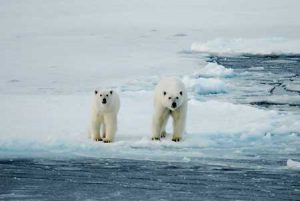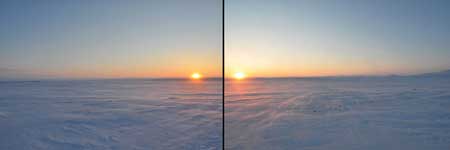
By Tamarah Feder
The facts are disturbing. By the end of last summer, Arctic sea ice coverage was at its second-lowest rate since satellite recording began in 1979. The ice covered an average of 6 million square kilometres, falling 22 per cent below the average extent from 1979 to 2000. The extent of the Arctic’s sea ice is dropping between nine and 11 per cent per decade. At that rate, it is expected there could be virtually no summer ice in the Arctic within the next 20 years.
The future for polar bears looks bleaker than an Arctic vista. Rapidly melting sea ice, particularly the summer ice, may contribute to triggering a impending devastation of the polar bear population, which scientists recently estimated to be between 20,000 and 25,000. It is expected that over the next 20 years, two-thirds of those animals could disappear. The remaining bears who live on a flank of the most northern tips of Canada and Greenland may find refuge there – at least for a while.
“Polar bears are at the top of the food chain in the Arctic, so if polar bears are suffering then that means the seals are suffering. Such drastic changes are devastating to the earth’s system of biodiversity, it has an impact on traditional ways of life for the communities who live there – and it is a warning to all humans who are responsible for the accelerated pace of these changes that something has to give.” – BRUNO TREMBLAY
Professor Bruno Tremblay, of McGill’s Department of Atmospheric and Oceanic Sciences, studies Arctic climate change. He and his colleagues (Stephanie Pfirman of Barnard College, Robert Newton of the Lamont Doherty Earth Observatory at Columbia University, and Charles Fowler from the University of Colorado) tag, follow and chart the lifespans of ice floes, and what they have witnessed is that the age (of the floes), which is directly related to the thickness of the sea ice, has decreased since 2007 at rates never seen before. And Tremblay is very concerned. Consequently, at least seven of the world’s estimated 19 polar bear subpopulations are known to be either in decline or under stress ecologically.
“Polar bears need the summer sea ice. It is the floor on which they walk as they search for food. It is also the home of numerous interconnected food sources. Without the sea ice, a vast system of biodiversity will disappear and the polar bear population will be endangered,” he said.
This situation is happening right now in Hudson Strait, where polar bears can usually be seen feeding on marine mammals at this time of year. Go there today and there is no sea ice. The causes of these recent and drastically quick melts and the inability of ice to age and thicken are widely understood to be a result of a combination of increasing greenhouse gas concentrations. Those emissions cause long-term declines in sea-ice thickness. Added to that, variabilities in wind patterns push sea ice from the Arctic into the Greenland Sea where even thick multi-year ice can melt substantially. This is what happened in 2007. Thinner ice is more mobile, so the loss of sea ice under the same wind patterns can be greater.
In other words, it is our fault. Hudson Strait provides an eerie signal of what’s to come if humans don’t quickly reduce CO2 emissions.
“While it’s true that there are things that can be done to save the Arctic sea ice,” Tremblay said, “it would require some drastic measures, and the global will to make the necessary changes is simply not there.” To be sure, emissions would need to be reversed right now to levels from more than a decade ago. It doesn’t seem like that’s about to happen. So the next question is how to mitigate the changes and allow existing ecosystems to adapt and preserve what exists now.
Saving what we can
At a recent press conference at the American Geophysical Union, Tremblay and his colleagues said their research suggests summer ice on the most northern coastlines of Canada and Greenland is expected to last for several decades longer than in the rest of the Arctic, raising the possibility of a naturally formed refuge for ice-associated species for the foreseeable future and offering favourable conditions for polar bears living there.
Tremblay explains why this is likely. “The refuge area collects thick, persistent ice because winds and ocean currents blow sea ice from the arctic into the region. Winds and ocean currents transport the ice formed during fall and winter across the Arctic Ocean. While large quantities of ice are exported out of the Arctic Basin through Fram Strait, ice also piles up along the northern flank of the Canadian Arctic Archipelago.”
Tremblay and his colleagues expect the refuge may endure because ice will continue to be transported into this region as the climate warms, and thicker ice is less likely to melt entirely during a single summer.
Tremblay and his colleagues propose that the refuge along the Canadian Arctic archipelago and northern Greenland be protected from “other potentially detrimental stressors such as transportation, tourism, resource extraction, contamination.” He sees the melting of Arctic sea ice as inevitable, but one in which the hope lies in how we adapt and how quickly we can do it. “Change is unavoidable, there has always been change. The concern is the rapidity of the change and what we can do to adapt.”

The art of telling the story
Born in Chicoutimi, Tremblay studied aeronautical engineering, but a fortuitous exchange program with the Swiss Federal Institute of Technology Zurich in Switzerland had him working with a scientist studying the dynamics of sheet ice and figuring out how they react to temperature changes. When he returned to Canada, he went ahead with his studies and found work with a major international engineering firm. But after a few years he lost interest, and a contact in Switzerland told him about people studying sea ice at McGill. Tremblay came here and completed his PhD. He then taught at Columbia University for 10 years.
Explaining some of the reasons he came back to Canada and McGill after that decade, he smiles while tapping his cheeks with both hands and says, “I like the cold. How it feels on my cheeks. And I like the spaciousness here.”
Tremblay travels to the North about twice a year to conduct research. More recently, his scientific passion has been enriched in other ways after travelling to Resolute Bay and Iqaluit in Nunavut with New York artist Jessica Houston. Her ability to connect with people living there through art opened up another route for his own ability to communicate.
“I was just tagging along with her, listening, but she was my entrance to those communities. Something I could not have achieved on my own,” he said. This unique partnership has led them to collaborate on several art projects that capture both the majesty and fragility of the region.
Following a scientist/artist residency in Iceland, they created two films, one about Resolute titled Qausuittuq (The Place with No Dawn) and the other, Solarhringur, filmed in Iceland, which compresses a 24-hour day into 12 minutes. The latter was shown at the International Polar Year Conference in Oslo last June.
“Instead of me showing a graph saying look at what’s happening to the ice, we found another way of communicating something important in a very quiet way. How often does one get to communicate to 50 people, especially scientists, and see them sit quietly for 12 minutes to watch something so peaceful? You come out of it differently. It gives you an opening to a place that goes beyond the intellectual. It makes you realize something in a visceral way.”
Together with Houston, Tremblay has also established an affiliation with Cape Farewell, the organization founded by artist and environmental activist David Buckland that pioneers a cultural response to climate change by bringing artists, writers, scientists, educators and media together on expeditions into the High Arctic.
Does it really matter if there are fewer and fewer polar bears?

Arctic sea ice flood web
Sea ice represents a unique ecosystem in the Arctic, providing habitat to specialized, ice-associated species that include micro-organisms, fish, birds, and marine mammals. Individual species use sea ice in different ways depending on their biological needs. Ice algae form the base of the food web. Some algae stay attached to the bottom of the ice, some fall into the water column, and some fall to the bottom of the sea providing food for species that feed at different depths. Protists (single-celled organisms) and zooplankton eat the algae which are then eaten by fish such as Arctic cod and sea birds, which in turn act as the major link to other fish and birds, seals, and whales. Polar bears prey on seals from the ice and walruses forage on clams from drifting pack ice.
The greatest reduction in Arctic summer sea ice extent since satellite observations began occurred in 2007, with the following two years experiencing the second and third biggest reductions. The Greenland ice sheet is currently losing more than 250 cubic km a year – faster than can be explained by natural melting.
Watch Bruno Tremblay discuss melting polar ice caps here: http://podcasts.mcgill.ca/environment/2009/04/22/melting-polar-ice-caps/
Watch the press conference from the American Geophysical Union’s 2010 meeting here: http://handouts.projectionnet.com/Recordings/AGUPressThu9AM.aspx
Watch Jessica Houston and Bruno Tremblay’s videos of the Arctic here: http://vimeo.com/user3504054

